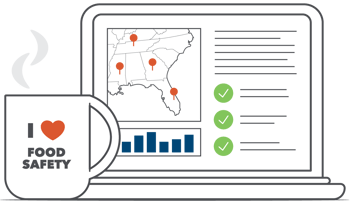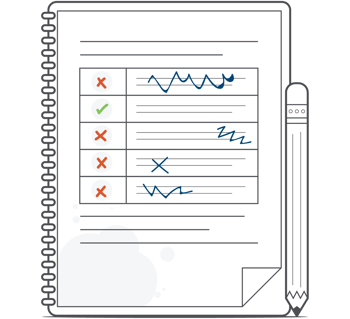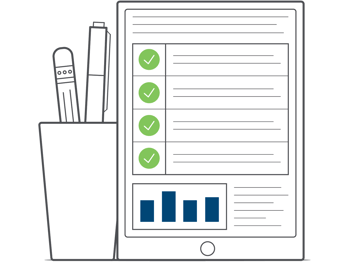Explore solutions built for your industry
Our customer-proven solutions monitor medications and food inventories for some of the most recognizable names in the industries of healthcare, food service, and transportation, and logistics. See how our solutions adapt to your industry needs.
SEE SOLUTIONSKroger Health Strengthens Compliance Visibility with SmartSense
Watch The VideoLEARN
Questions? Call +1 (866) 806-2653 to speak to our experts.
Schedule demoQuestions? Contact us.
Call +1 (866) 806-2653 to speak with our experts or get started with a demo.
CONTACT USAbout Us
SmartSense was created to use the power of the Internet of Things (IoT) to help our customers protect the assets most critical to the success of their business.
See our storyCONNECT. PROTECT. RESULTS.
Questions? Call +1 (866) 806-2653 to speak to our experts.
Schedule demoPlease select your login
Retail & Food Service Operations Checklists
Food safety is no simple task. From employee training to managing the supply chain, there are many points of failure that can lead to foodborne illness. It's not all bad news – with the rise of IoT and digital solutions providing visibility and insight, food service professionals now have the ability to significantly reduce foodborne illness risk.

1
Digitalizing Food Service Operations
Digital operations are the way of the future. You don’t have to search far to see its significant impact on the retail and food service space. From beacons to omnichannel to cashier-less convenience stores, the digital revolution has only just begun. Far too many organizations still depend on paper processes, without realizing the benefits of implementing a digital solution. In this post, we’ll outline the many advantages of moving away from manual processes to embracing food service operations digital checklists, which provide a means to improve both store operations and customer experiences.
Digital Food Safety Operations Checklist
Every food service organization has an obligation to keep their customers healthy. This is a reasonable expectation from consumers and a legal requirement from regulatory agencies. Adopting digital checklists eases this burden, through more effective food safety management, automation of manual operations, and reduction of inventory loss.
Gain Food Operations Visibility and Accountability
Manual processes that rely on pen and paper are difficult to manage. Leveraging digital solutions improves task management.
Ensure HACCP Compliance Management
Ensure HACCP compliance with continuous temperature monitoring and proactive temperature excursion detection.
Automate Manual Food Safety Operations
Streamline costly, error-prone, and labor-intensive operational checklists and reporting to reduce food safety risk.
Digital solutions enable proactive management of temperature excursions, a significant improvement in reacting to incidents after they have already occurred. Paper methods require review after incidents have made their mark, by which time the damage has potentially been dealt. Digital food safety operations improves insight into possible gaps in food safety strategies.

Remote Food Safety Task Management
Remote task management provides a more streamlined process for critical activities, such as ensuring that tasks are being completed as expected and making updates to daily line checks. A centralized food operations checklist enables optimization of poor performing stores and allows upper management to identify weak points across multiple locations. Site-wide visibility enables managers to compare store performance across their enterprise, paving the way to making every store operate more consistently with brand standards. This reduces brand risk and provides an efficient means of increasing food quality control.


2
Tackling Food Safety with Digital Checklists
Food safety is complex. Not only is it complex, but its importance cannot be understated. Each year, 48 million people get sick from foodborne illness, and 3,000 of those cases result in death. Effective food safety plans help reduce the risk of foodborne illness, but these plans typically involve manual, error-prone processes that can cause foodborne illness simply because of a single missed step. This does not have to be the case – adopting a system of digital checklists can help manage food safety for one store to a chain of 1,000 stores. Let’s get started on the process of adopting digital checklists to manage food safety strategy.
Transitioning Food Safety Solutions from Paper to Digital Checklists
Too many food service organizations rely on manual processes and paper checklists to complete the many tasks necessary to ensure safe food practice. Paper checklists are cumbersome and do not provide enough visibility into compliance efforts. Despite this, companies are hesitant to adopt a digital solution because of the effort required to move from a manual system to a digital solution. Here, we will outline the 5 steps to implement a digital food safety solution.
-
Identify Tasks to be Completed
Includes daily operations to ensure food safety and uphold brand standards. -
Group Tasks by Necessary Completion Time
Streamline tasks based on the ideal order of operations. -
Prioritize by Store Layout
Optimize and plan for efficient task completion based on location and timing of tasks. -
Set Corrective Actions for Excursions
Identify necessary steps for when anomalies are detected. -
Update Tasks, Priorities, and Corrective Actions Based on Analysis
Review processes and identify areas for improvement.
Replacing Food Safety Redbooks
Paper still dominates many food service organizations. Manual processes are inefficient, error-prone, and provide little visibility into what actually takes place. Stacks of paper are difficult to organize, let alone analyze in the case of a food safety compliance audit. Digital checklists provide more value than paper solutions like Redbooks because of their ability to be easily analyzed, the ease with which they allow you to update tasks, and the increased consistency they ensure across stores. Paper methods provide a snapshot in time, and cannot be used for continuous, real-time monitoring efforts. In addition, moving toward digital solutions can provide immense value over their paper counterparts:
Reduce Daily Logbook Operations
Visibility into task completion, points of failure, and how food safety initiatives can be improved.
Employee Shift Management
Accountability improvements drive employee performance insights.
Source of Truth
Assurance that employees are receiving accurate information.
Pen and Paper Methods are Difficult
Sifting through paper can take hours as opposed to minutes.
Eliminating paper processes is not only good for the environment, but it also provides new sources of valuable information. Data points not previously available are now accessible. Photos and videos can be recorded and stored for future reference, and in the unfortunate event of an excursion, can provide a detailed account of what went wrong and what steps were taken to remedy the matter.


3
Digital Food Operations Checklists Benefits
Digital checklists provide unprecedented visibility into the effectiveness of food safety strategies. Previously, tasks would be recorded manually on paper, which can be challenging, if not impossible, to analyze at scale. Digital checklists help to realize the benefits of a proactive food safety strategy. Most food service organizations respond to food safety incidents well after events have taken place and use paper records as a means to explain what had gone wrong. By this time the damage has already been done. Digital checklists enable visibility into compliance and operational procedures, regardless of scale. From a single store to nationwide chains, graduating from paper unlocks insights that can help prevent foodborne incidents.
Increase Food Operations Accountability
Paper provides little accountability into task completion: the who, when, and why of each action is not documented well in manual processes. Digital checklists provide timestamps and signatures as tasks are completed, enabling new insights into points of failure that help to identify opportunities for improvement. It’s important to keep a few things in mind for these new levels of accountability:
Clear Communication
Providing a concise overview of the "why" of each task.
Set Expectations
Expectations need to be set during training so that employees understand the work that they will be responsible for.
Constructive Feedback
Provide feedback early and often. Criticism does not help employees improve their work.
Praise
Recognize employees for their outstanding achievements, and make sure they are aware when they go above and beyond their job.
Pen and paper methods are error-prone and subject to falsification. Reporting accuracy reliability increases significantly when using a digital solution. With digital checklists, task completion is documented and stored in the cloud, enabling managers to easily review how well employees perform their tasks.

Simplify Workflow Management
Plain and simple, people hate paper checklists. Many organizations have hundreds of pages necessary to outline the many regularly scheduled tasks that need to be completed every day. Not only does digital task management eliminate the need for endless paper trails, but it also provides a simpler way of making updates on the fly. National chains can now modify their daily line checks at the push of a button, and do not have to worry about whether or not each individual store received the update.

4
Food Service Operations Task Management
Digital checklists act as an operational execution platform, enabling organizations to gain unprecedented visibility into employee efficiency and food safety initiatives. Managing workflows for multiple stores is greatly simplified, and allows for managers to monitor enterprise-wide performance, in addition to gaining store-specific metrics. The benefits realized by digital checklists extend past food safety and into the customer experience, improving routine tasks and corrective actions alike.
Standard Operating Procedures in Restaurants
One of the biggest drivers of a successful foodservice operation is developing and maintaining standard operating procedures that prioritize food safety initiatives. While some recurring tasks are meant to improve the customer experience, many are focused on ensuring customer health. These tasks need to be done correctly, as a single lapse in the established process can cause foodborne illness. From meeting industry regulations (which we will cover in detail later in the post) to ensuring consistency throughout chain stores, standard operating procedures (SOPs) can make or break a food safety program. But how do you manage SOPs for stores spread across the nation? A centralized operations management platform significantly reduces the effort required for managing and updating operating procedures. Updates are shared instantaneously through the digital platform; individual stores do not need to worry if they are up-to-date with SOPs. Additionally, digital checklists ensure that customers have consistent experiences across franchise stores. This is essential in holding and improving customer retention rates.
Daily Store Checks
Above all else, food service organizations are expected to keep their customers healthy. Digital checklists ensure that food is safe and ready to serve to guests. A single lapse in food safety can cause widespread foodborne illness, leading to loss of profits or worse. One of the most critical methods of preventing illness is through effective line checks. Most, if not all, businesses will have already implemented plans for line checks, but do not have robust visibility into these checks. Paper line checks provide the tasks that need to be accomplished but do not necessarily provide corrective actions in the case that an excursion is detected. Digital solutions provide more complete line checks and can be updated instantaneously, leading to significantly improved food safety strategies. By leveraging wireless temperature probes, employees can automatically record and identify excursions in hot or cold food items for acceptable ranges. If an excursion is detected, a digital solution can immediately recommend the corrective action.


Shift to Shift Communication
Communication between managers is essential for shift changes. With digital checklists, managers can transition from shift-to-shift seamlessly and have access to valuable information that informs them of their priorities for the shift. Managers can easily understand which tasks were completed, and what to prioritize for the next shift. This simplifies communication and ensures that restaurant operations run smoothly and effectively.
Food Service Employee Time Optimization
From understanding employee strengths to managing sick days, optimizing employee productivity is a crucial component of being an effective manager. Customers demand outstanding experiences and will take their business elsewhere if their needs are not met. This puts immense pressure on businesses to ensure employees are meeting these demands. Without an effective task management solution, managers will struggle to satisfy this shift in expectations. How employees spend their time is critical to success. Streamlining recurring tasks can ease this burden, and provide insight into whether or not employees are spending their time wisely.
In addition to scheduling work, digital task management platforms can automate follow-up tasks to handle unexpected outcomes. When excursions are detected, employees can be notified of the proper steps that need to be taken to resolve the issue. This reduces the chance of responding incorrectly to an excursion event and improves the likelihood of an appropriate response.

Food Operations Employee Training
Employees will not be able to stick to standard operating procedures if they are not properly trained. Equipping staff with the tools they need will help to ensure that they are careful when handling food is paramount in the fight against foodborne illness. Effective training includes the “what,” the “how,” and often overlooked but equally important, the “why.”
The "What"
Employees need to know exactly what must get done and when in order to ensure successful business operations. This includes their day-to-day tasks and what to do if an excursion is detected. Digital checklists are ideal for this, as they specifically outline required tasks.
The "How"
Once employees know the tasks they are responsible for, they need to be taught how to get it done. This step is crucial for setting standards in food safety and can be supplemented by detailed instructions when setting up digital checklists.
The "Why"
Why these tasks are necessary is almost as important as the “what” and the “how.” If employees do not understand how their actions will improve food safety, they do not know how impactful their actions are.

5
Food Safety Compliance Management / Documentation
Compliance. Documentation. Scary as it is, it can be tamed. One of the most significant advancements in food safety came as a result of robust compliance requirements outlined by governing regulatory bodies, such as The Food and Drug Administration (FDA) or The United States Department of Agriculture (USDA). Despite the frustration that may come with maintaining compliance, it is imperative to ensure food safety initiatives are being met.
Hazard Analysis and Critical Control Points (HACCP)
HACCP, first developed for space missions in the 1950s, provides a system designed to identify and prevent safety hazards during food production and distribution. Digital checklists can supplement each of the seven steps of a robust HACCP plan:
- Conduct a Hazard Analysis
- Determine the risks of each potential hazard, including biological, chemical, or physical properties, during production and distribution.
- Preventative measures are then categorized and listed as employee responsibilities in day-to-day work.
- Identify the Critical Control Points (CCP)
- Each CCP is a step where controls can be applied to prevent hazards, enabling proactive management of food safety.
- These steps are then used for guiding task management.
- Establish Critical Limits
- Identify the maximum or minimum value at which a hazard must be controlled at each CCP.
- This information is used in the digital checklist to alert employees when corrective actions are required for each CCP.
- Establish Monitoring Procedures
- Specific monitoring activities are implemented to confirm that hazards are under control.
- Digital checklists provide a way to confirm whether all monitoring activities were completed.
- Establish Corrective Actions
- Corrective actions, or tasks meant to remedy an issue, ensure that problems are dealt with before they become a hazard.
- If an excursion is detected, digital checklists can inform the employee of how to correct the issue.
- Establish Record Keeping Procedures
- Formal documentation is required to demonstrate that the business has met the critical limits of each CCP.
- Digital records indicate which actions, both standard tasks and corrective actions, were taken throughout the day to ensure food safety.
- Establish Verification Procedures
- The final, most critical step of HACCP, is to ensure that the plan is both adequate and working as intended.
- Digital checklists provide a means to confirm tasks are being completed, identify points of failure, and provide documentation of compliance.
How To Comply with FSMA Regulations
FSMA set new standards for how best to manage food safety through proactive measures. Regulations outlined by complying with FSMA help to increase food safety visibility, reduce risk, and ensure compliance by implementing proactive measures throughout the supply chain. The idea seems simple enough, but the amount of work that is expected of truck drivers puts enormous strain on their workload. Tasks can easily be missed, and without efficient methods of confirming task completion, it's nearly impossible to understand where failure points were. Digital checklists provide real-time visibility into compliance, and help to remind drivers of their many responsibilities.
Prevent Foodborne Illness with ServSafe
ServSafe, a program introduced by the National Restaurant Association (NRA), outlines proper training for employees as it relates to storing, handling, preparing, and serving food. ServSafe’s focus is on foodborne illness, and prevention methods for different pathogens. As discussed earlier, training is essential in ensuring food safety. Employees are the frontlines of serving and preparing food for guests, and need to be properly trained to avoid foodborne illness. Training programs are only effective if employees are carrying out their tasks. Digital checklists help to reinforce training among employees, leading to higher compliance rates and visibility into task completion.


6
Time to Upgrade to a Digital Food Service Solution
Every foodservice organization has the opportunity to greatly improve their food safety initiatives through implementing digital solutions. By digitalizing store operations, businesses can improve food safety, automate manual operations, and reduces inventory loss. Remote task management streamlines processes and identifies points of failure, centralizes workflow management for more efficient updates when changes are needed, and provides site-wide visibility into store operations. Daily line checks can be reviewed and updated from any device, granting managers a simplified process to improve employee performance. Finally, compliance management is greatly simplified, providing peace of mind that food safety is under control.
CONNECT. PROTECT. RESULTS.
Learn how our complete critical environment monitoring solution will help you connect and transform your business.
Call +1 (866) 806-2653 to speak with our industry experts or get started by requesting a demo.
SCHEDULE DEMO



